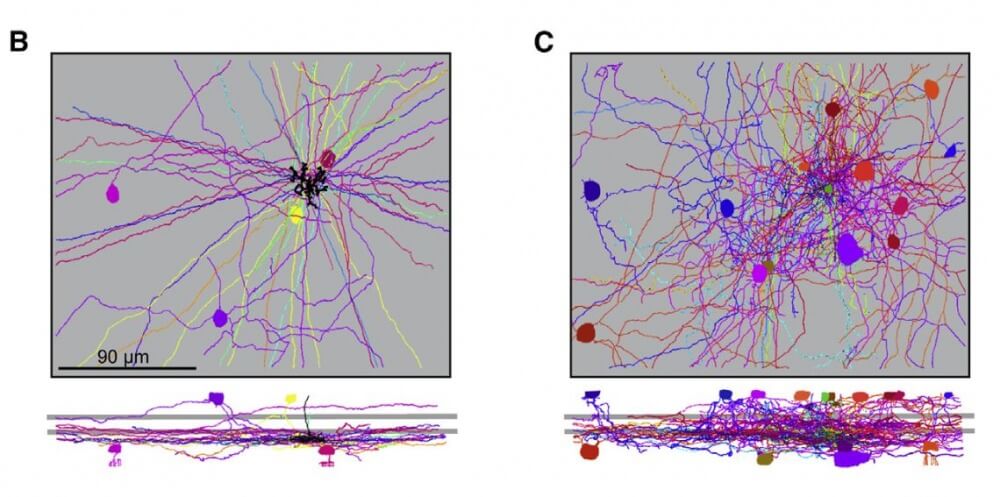Dr. Shai Sabah from the Faculty of Medicine at the Hebrew University, one of the leaders of the research published in Neuron: "The popular opinion was that each nerve cell functions as an independent entity. In contrast, we now understand that each of the synapses (junctions through which signals pass between cells) functions independently. Each nerve cell can be described as a body with hundreds or thousands of arms (synapses), where each of the arms can perform a completely different action, almost independently of the surrounding arms"

Nerve signals that reach the ends of the nerve cell are processed in the cell body and transmitted to other nerve cells through small junctions, called synapses. For decades, the general assumption was that the activity in the cell body is similar to the activity in each of its synapses, however a new study by Dr. Shai Sabah from the Faculty of Medicine at the Hebrew University and Prof. Kisuke Yunhara from the Biomedical Department at Aarhus University, published in the scientific journal Neuron, changed the perception the existing The researchers showed for the first time that different synapses of the same neuron can send different pieces of information, so that in fact a single neuron can send different information to a large number of neurons. In other words, the researchers showed that the unique organization of the synapses makes it possible to perform a large number of calculations simultaneously by a single nerve cell, and to produce a huge diversity in the type and amount of information transmitted. The discovery of this mechanism may allow future studies to explain many other phenomena of the nervous system that have not yet been deciphered.
The researchers used a neural circuit in the mouse retina that specializes in detecting the direction of movement as a model system. In the retina, detectors called photoreceptors absorb the light entering the eye, and convert it into electrical signals. These signals are then transmitted to other retinal cells, called bipolar cells. These cells carry the signal, and like runners in a relay race, transmit the signal through synapses to other nerve cells that report the direction of movement to the brain - these cells are called ganglion cells. The ganglion cells work vigorously when objects move in the visual field in one direction, but do not work at all when objects move in the opposite direction. The bipolar cells, until now, were only seen as messengers, passing a message from the detectors to the ganglion cells, and from there to its destination in the brain.
Previous studies have measured the total number of signals that a bipolar cell sends through its synapses, and found that this sum is very similar to the signal measured from the cell body. On the other hand, in the current study Prof. Yunhara and Dr. Sabah found that this impression hides a much more interesting communication between the retinal cells. First, by measuring the activity of each of the synapses separately, it was revealed that each synapse behaved differently. Second, the researchers discovered that some of the synapses were sensitive to the direction of movement - they only worked when the observed object moved in a certain direction. To their surprise, the researchers discovered that each bipolar cell tested contained four populations of synapses, each with a different preferred direction of movement - up, down, forward or backward.
It is known that nerve stimulation can increase or decrease the activity level of synapses, but it seems that the synapses in the bipolar cells are much more sophisticated - they show a special sensitivity to a certain direction of movement. The researchers also discovered the mechanism that enabled a unique calculation for each such synapse, and the mechanism seems to be based on a comparison between signals received from two other types of nerve cells, each of which uses a different chemical substance (called a neurotransmitter). These findings revealed that the sensitivity to the direction of movement is calculated independently in each of the synapses, so that a single bipolar cell can transmit signals about different directions of movement to different ganglion cells. In addition to this, the bipolar cells are smaller and denser than ganglion cells and therefore, the invention of all four different populations of synapses, in each of the bipolar cells, allows the retina to distinguish the differences in the direction of movement of objects with extremely high resolution, across the entire field of vision.
"Conceptually, this study reveals an unexpectedly high computational capacity of synapses in mammalian neurons, and provides significant insights into how a large number of unique signals can be generated from a single neuron," concluded Dr. Sabah this week. "Until now, the popular opinion was that each nerve cell functioned as an independent entity. In contrast, we now understand that each of the synapses, which transmit signals to other cells, functions independently. By analogy, each nerve cell can be described as a body with hundreds or thousands of arms (synapses), where each of the arms can perform a completely different action, almost independently of the surrounding arms. These discoveries constitute a breakthrough and a new direction in the field of brain research."
The academic work was carried out by two research teams, one included Akihiro Matsumoto and Stella Solveig Nolt from the laboratory of Prof. Kisuke Yunhara at the University of Aarhus in Denmark, and the other included Wiam Agbaria, Ravan Andreas, and Hedra Levy from the laboratory of Dr. Shai Sabah at the Faculty of Medicine at the Hebrew University.
